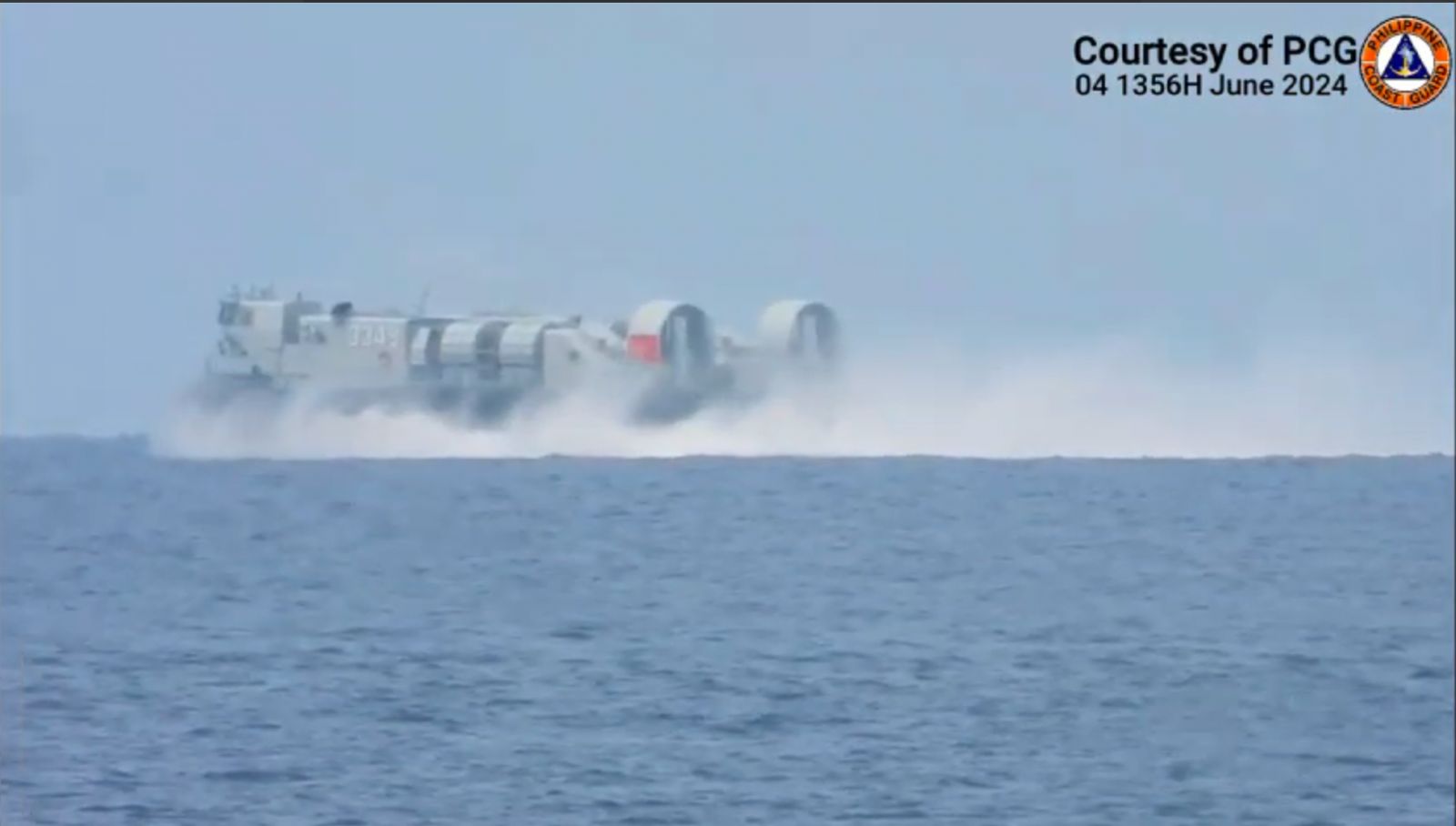Chinese ships have left Sabina Shoal in West Philippine Sea – Navy

One of the Chinese Navy hovercraft during its military drills in the vicinity waters off Escoda (Sabina) Shoal. SCREENGRAB FROM PHILIPPINE COAST GUARD’S VIDEO CLIP
MANILA, Philippines — Chinese ships appear to have left the waters at the Escoda (Sabina) Shoal in the West Philippine Sea, according to the Philippine Navy.
From June 18 to June 24, no China Coast Guard (CCG) ships, People’s Liberation Army-Navy (PLA-N) warships, or Chinese maritime militia (CMM) vessels were spotted in Sabina Shoal.
This absence was a stark contrast to the data logged on the previous monitoring week (June 11-17) when there were four PLA-N warships, three CCG ships, and 13 CMM vessels monitored near Sabina Shoal.
READ: China deploys hovercraft during ‘illegal’ drills in West Philippine Sea
Also, on June 4, China conducted its amphibious drills in Sabina Shoal, which saw the deployment of PLA-N’s Type 071 amphibious transport dock which hosted hovercrafts. According to the Philippine Coast Guard (PCG), the deployment of hovercrafts in the West Philippine Sea is unprecedented.
PCG’s BRP Teresa Magbanua has been deployed near Sabina Shoal since April in response to suspected island reclamation activities there.
Waiting for PH’s next move
Sabina Shoal also serves as the rendezvous point for Filipino vessels carrying out resupply missions to naval troops stationed on the BRP Sierra Madre, grounded in nearby Ayungin (Second Thomas) Shoal. The resupply mission for this naval outpost has become one of the flashpoints of tension between Manila and Beijing.
READ: West Philippine Sea sees turnover rites for PCG’s biggest ship amid CCG presence
Security expert Chester Cabalza on Wednesday said the absence of Chinese ships and warships in Sabina Shoal might indicate that China is gauging the situation after the Ayungin Shoal incident.
The June 17 incident in BRP Sierra Madre saw the most violent actions by CCG personnel so far, which the Philippine military said led to what they deem as “looting” and even caused serious injury to one of its naval personnel.
“I deem CCG is recalculating its presence after the confrontation with Filipino navy sailors,” Cabalza, founder of Manila-based think tank International Development and Security Cooperation, told INQUIRER.net.
Chinese assets might have left Sabina Shoal, but Cabalza noted that many of its assets are in its nearby outposts.
READ: PH Navy challenges ‘illegal’ drills of Chinese warships in Sabina Shoal
Beijing has 20 outposts in the Paracel Islands and seven in the Spratly Islands in the South China Sea.
“China is known for their rapid response and sudden attack during resupply missions,” Cabalza said. “At least for now, they are awaiting for the next move in our resupply mission.”
China ships remain
Chinese vessels, however, remain in other West Philippine Sea features, the navy data also showed, with a total of 129 ships monitored in six maritime features from June 11 to 17.
Four PLA-N warships and 34 CMM vessels were spotted in Ayungin Shoal while five CCG ships, one PLA-N warship and 15 CMM vessels were recorded in Scarborough (Panatag) Shoal.
Pag-asa Island, or the capital of the Kalayaan Island Group, saw three CCG ships and 34 CMM vessels.
Recto Bank saw 25 CMM vessels, while Lawak Island and Panata Island had one CMM each off their waters.
Beijing’s presence there is in line with its assertion of sovereignty in almost the entire South China Sea, including most of the West Philippine Sea, even if such a claim has been effectively invalidated by the arbitral award issued in July 2016.
The landmark ruling stemmed from a case filed by Manila in 2013, a year after its tense standoff with Beijing over Panatag Shoal, whose lagoon the latter now effectively controls.
For comprehensive coverage, in-depth analysis, visit our special page for West Philippine Sea updates. Stay informed with articles, videos, and expert opinions.


















